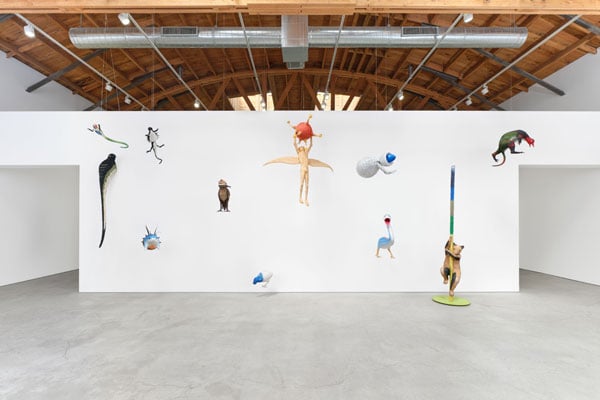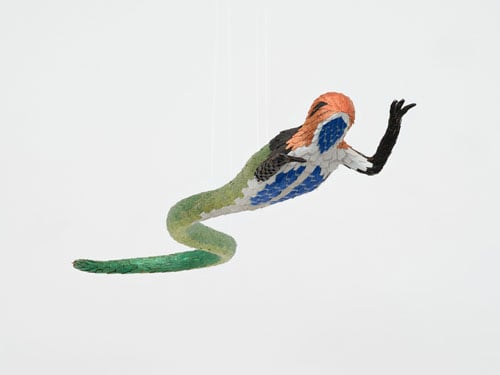STRANGE CREATURES
by Paula Mejía

A view of Roberto Benavidez's Bosch Beasts at Perrotin. (Paul Salveson / Roberto Benavidez / Perrotin)
In the early 16th century, a secretary named Antonio de Beatis accompanied Luigi d’Aragona, an Italian cardinal, on a European sojourn while extensively detailing their travels in a diary. When the two stopped to visit the Brussels palace of Count Henry III of Nassau in 1517, they laid eyes on something they’d never seen before: An elaborately-painted triptych, depicting nude figurines and strange animal hybrids in various surrealistic scenes that also drew on Biblical themes.
Although these triptychs were a familiar sight in churches at the time, it’s doubtful that the piece known as The Garden of Earthly Delights, painted by the Dutch artist Hieronymous Bosch sometime around the turn of the 16th century, was meant to accompany a congregation doused in incense and prayer: The artwork’s blatant horniness — with its overheated romping and plentiful bare butts — would have been out of step in a cathedral. Still, in his diary, De Beatis marveled at the “bizarre things” he observed in Bosch’s panels: “Birds, animals of all kinds, executed very naturally, things that are so delightful and fantastic that it is impossible to describe them properly to those who have not seen them.”
More than five centuries later, de Beatis’ description about Bosch’s feral triptych — now housed in Madrid’s Museo Nacional del Prado — still feels relevant. But it’s also a fitting characterization for the dazzling batch of work by the Los Angeles-based artist Roberto Benavidez. For his solo show, on view for one more week at Mid-City’s Perrotin gallery, Benavidez plucked various creatures flitting through The Garden of Earthly Delights, and another Bosch triptych, The Hermit Saints, and transformed them into extravagant piñatas.

Bosch Beast No. 10, 2020. (Paul Salveson / Roberto Benavidez / Perrotin)
In the aptly-titled Bosch Beasts, the Mexican American artist brings a bounty of whimsical beings, including fowl, amphibians, and mammals, to the gallery. Some bear likenesses to recognizable animals of our world, such as a bird that appears to be pecking at a kernel. Except Benavidez’s bird is clutching a classic seven-sided mini-piñata in its mouth, a playful wink at how the artist is both subverting Bosch’s celebrated work and also the traditional folk artform of piñata. (If you peer at the center of Bosch’s triptych, you’ll find this same bird.) Other figures in Benavidez’s show — including one that looks like a badger and a reptile mated, and another capybara-esque critter that could be mistaken for a chicken when viewed from a certain angle — exist in an otherworldly realm of the contemporary artist’s imagination.
Benavidez’ piñatas bear little resemblance to the cheery, plump vessels stuffed with treats at children’s birthday parties. But his delicate sculptures are made from the same humble materials that artisans have long used to craft piñatas: crepe paper, glue, wire. His methods for creating them are similar, too. To make a new sculpture, Benavidez swathes layers of paper-mache around two balloons, then adds slivers of glue-dripped paper. More layers of paper-mache and some wire give further shape to the piñata’s body. Gradually, he adds features such as limbs and tails. Benavidez has also hidden something inside each piñata, but he’s secretive about what mysteries they might contain.

Bosch Beast No. 14, 2025. (Paul Salveson / Roberto Benavidez / Perrotin)
Benavidez, a former bronze sculptor, told The New York Times last year that working with piñatas felt “liberating because it was paper, so I knew I’d never be priced out of my art.” But the no-frills material led him to find a deep respect for the craft. “I used to say the reason I started with the piñata was to find a more accessible medium,” he observed in that same interview, “but the reason I have stayed is because I’ve discovered the richness of its history.”
In Benavidez’s hands, one of the piñata’s defining elements, its thick fringes hanging from the sides, becomes the conduit for scintillating detail. Tiny rows of shimmering crepe paper morph into glimmering jade-green scales on a snake-like creature crossed with a monkey. Or, it can mimic the fluffy feathers on a winged animal — in this case, grinning maliciously as it clutches an unsuspecting frog in its jaw.
The way Benavidez utilizes fringe in his piñata sculptures bears a deeper significance than a shrewd artistic choice, though. The popular craft has always existed on the margins, in a sense, because its artisans use everyday materials; it isn’t often thought of as high art. Drawing from his background as a mixed-race and queer artist, Benavidez’s distinctive sculptures also nod to the mutability of identity, which is often experienced by those who have lived on the fringes.

Benavidez depicts otherworldly creatures, as well as an angel clutching a seven-pointed star, at right. (Paul Salveson / Roberto Benavidez / Perrotin)
Much like the Bosch triptychs that inspired it, Benavidez’s work bears religious undertones. The only piece in his baker’s dozen of piñatas that does not feature an animal notably depicts an angel, grasping the traditional seven-sided star as though to avoid a descent to earth, or even hell. The seven-sided piñatas themselves have traditionally held a spiritual significance, with each point nodding to one of the seven deadly sins.
Ultimately, Benavidez’s pieces aren’t what you might find at a party store, but they inspire a similar playful wonder recognizable to those who dare step up and blindly bash a piñata. They do so even though they might look foolish, trusting that their instincts will lead them towards the ultimate prize: the bounty inside.
🐦🐧🐤
Roberto Benavidez, Bosch Beasts, is on view at Perrotin through October 18th; perrotin.com.
.png?upscale=true&width=1200&upscale=true&name=email(600x74).png)